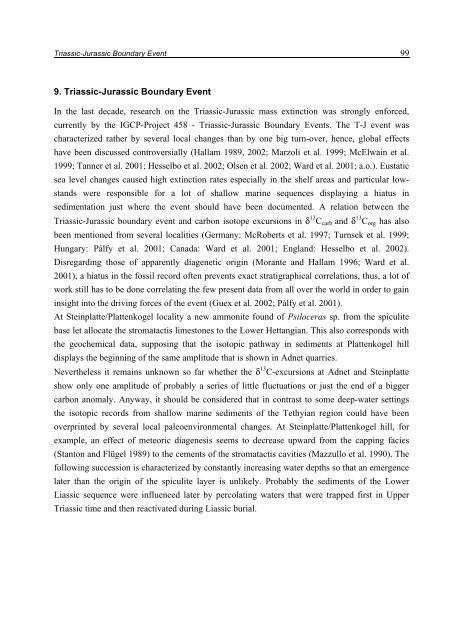Porifera-microbialites of the Lower Liassic (Northern Calcareous ...
Porifera-microbialites of the Lower Liassic (Northern Calcareous ...
Porifera-microbialites of the Lower Liassic (Northern Calcareous ...
Create successful ePaper yourself
Turn your PDF publications into a flip-book with our unique Google optimized e-Paper software.
Triassic-Jurassic Boundary Event 99<br />
9. Triassic-Jurassic Boundary Event<br />
In <strong>the</strong> last decade, research on <strong>the</strong> Triassic-Jurassic mass extinction was strongly enforced,<br />
currently by <strong>the</strong> IGCP-Project 458 - Triassic-Jurassic Boundary Events. The T-J event was<br />
characterized ra<strong>the</strong>r by several local changes than by one big turn-over, hence, global effects<br />
have been discussed controversially (Hallam 1989, 2002; Marzoli et al. 1999; McElwain et al.<br />
1999; Tanner et al. 2001; Hesselbo et al. 2002; Olsen et al. 2002; Ward et al. 2001; a.o.). Eustatic<br />
sea level changes caused high extinction rates especially in <strong>the</strong> shelf areas and particular low-<br />
stands were responsible for a lot <strong>of</strong> shallow marine sequences displaying a hiatus in<br />
sedimentation just where <strong>the</strong> event should have been documented. A relation between <strong>the</strong><br />
Triassic-Jurassic boundary event and carbon isotope excursions in δ 13 Ccarb and δ 13 Corg has also<br />
been mentioned from several localities (Germany: McRoberts et al. 1997; Turnsek et al. 1999;<br />
Hungary: Pálfy et al. 2001; Canada: Ward et al. 2001; England: Hesselbo et al. 2002).<br />
Disregarding those <strong>of</strong> apparently diagenetic origin (Morante and Hallam 1996; Ward et al.<br />
2001), a hiatus in <strong>the</strong> fossil record <strong>of</strong>ten prevents exact stratigraphical correlations, thus, a lot <strong>of</strong><br />
work still has to be done correlating <strong>the</strong> few present data from all over <strong>the</strong> world in order to gain<br />
insight into <strong>the</strong> driving forces <strong>of</strong> <strong>the</strong> event (Guex et al. 2002; Pálfy et al. 2001).<br />
At Steinplatte/Plattenkogel locality a new ammonite found <strong>of</strong> Psiloceras sp. from <strong>the</strong> spiculite<br />
base let allocate <strong>the</strong> stromatactis limestones to <strong>the</strong> <strong>Lower</strong> Hettangian. This also corresponds with<br />
<strong>the</strong> geochemical data, supposing that <strong>the</strong> isotopic pathway in sediments at Plattenkogel hill<br />
displays <strong>the</strong> beginning <strong>of</strong> <strong>the</strong> same amplitude that is shown in Adnet quarries.<br />
Never<strong>the</strong>less it remains unknown so far whe<strong>the</strong>r <strong>the</strong> δ 13 C-excursions at Adnet and Steinplatte<br />
show only one amplitude <strong>of</strong> probably a series <strong>of</strong> little fluctuations or just <strong>the</strong> end <strong>of</strong> a bigger<br />
carbon anomaly. Anyway, it should be considered that in contrast to some deep-water settings<br />
<strong>the</strong> isotopic records from shallow marine sediments <strong>of</strong> <strong>the</strong> Tethyian region could have been<br />
overprinted by several local paleoenvironmental changes. At Steinplatte/Plattenkogel hill, for<br />
example, an effect <strong>of</strong> meteoric diagenesis seems to decrease upward from <strong>the</strong> capping facies<br />
(Stanton and Flügel 1989) to <strong>the</strong> cements <strong>of</strong> <strong>the</strong> stromatactis cavities (Mazzullo et al. 1990). The<br />
following succession is characterized by constantly increasing water depths so that an emergence<br />
later than <strong>the</strong> origin <strong>of</strong> <strong>the</strong> spiculite layer is unlikely. Probably <strong>the</strong> sediments <strong>of</strong> <strong>the</strong> <strong>Lower</strong><br />
<strong>Liassic</strong> sequence were influenced later by percolating waters that were trapped first in Upper<br />
Triassic time and <strong>the</strong>n reactivated during <strong>Liassic</strong> burial.

















